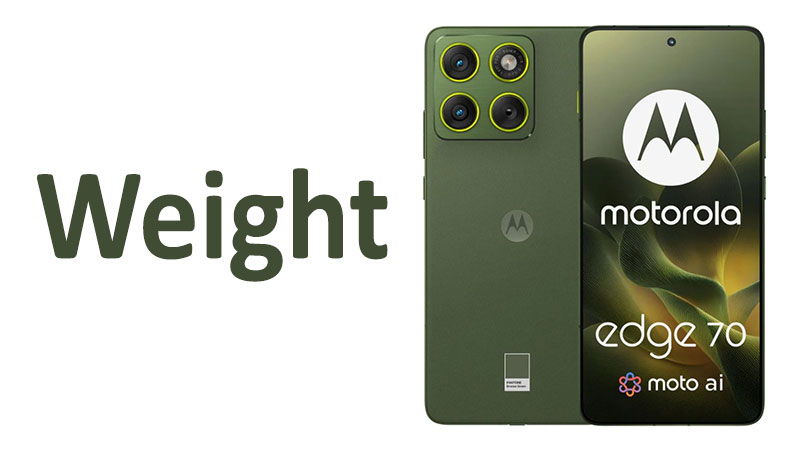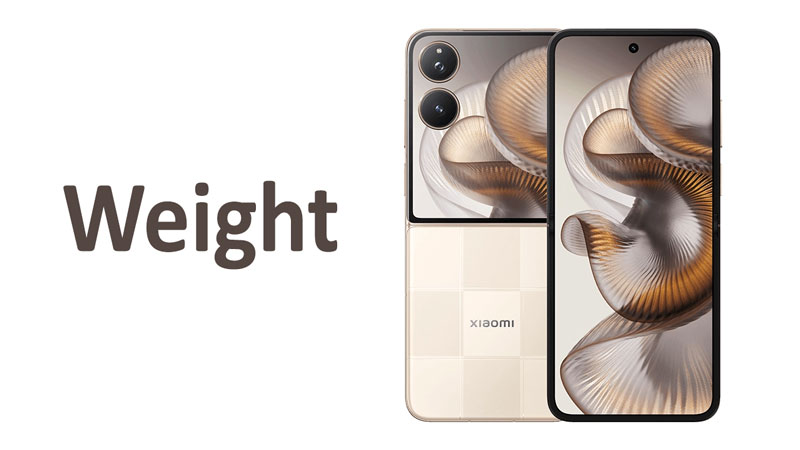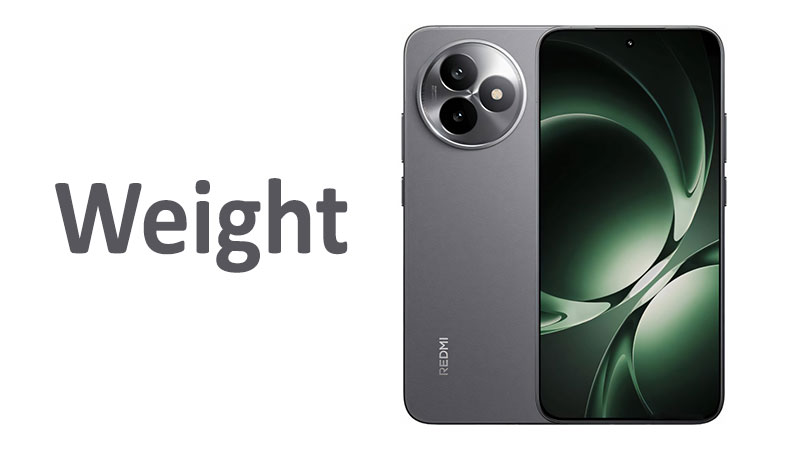The Motorola Edge 70 weight is a primary factor influencing its daily usability and comfort. Device mass profoundly affects how a user interacts with their phone over time. We recognize that weight dictates long-term holding fatigue. It significantly impacts the phone’s overall portability, therefore. Understanding the exact figures helps consumers make better purchasing decisions. This detailed analysis will thoroughly examine the Motorola Edge 70’s exact weight specification. We will investigate the implications of its lightweight design. Furthermore, we will compare this mass against competing models and previous generations. This comprehensive review reveals why the phone’s low mass is a defining feature.
Core Weight Specification: 159 Grams (5.61 Ounces)
The Motorola Edge 70 weighs exactly 159 grams (g). This measurement translates to 5.61 ounces (oz) in the imperial system. This figure is instantly recognizable as exceptionally light within the modern flagship landscape. Most large-screen smartphones today exceed 180 grams. Therefore, the 159 g specification sets the Edge 70 apart immediately. It confirms the phone’s commitment to superior lightness and portability.
The Significance of the Gram Measurement
A weight of 159 grams is highly desirable for current smartphone consumers. Manufacturers increasingly focus on larger screens and huge batteries. Consequently, device mass has steadily crept up over the past few years. Many premium phones now regularly approach or surpass 200 grams. The Edge 70 resists this growing trend successfully. It delivers a full-sized 6.7-inch experience with a refreshingly low mass.
The low device weight directly contributes to better ergonomics. It fundamentally improves the user experience. You notice the difference particularly during prolonged periods of use. Think about streaming long videos or extended gaming sessions. This reduced mass dramatically minimizes hand and wrist fatigue. This is a critical factor for heavy smartphone users.
The Ounce Equivalent: 5.61 Ounces
The imperial measure of 5.61 ounces is also very instructive. Consumers in regions using the imperial system immediately grasp the lightness. To visualize this, 5.61 ounces approximates the weight of a standard baseball. It feels much lighter than a full deck of playing cards, for instance. This lightness is achieved despite the phone’s large 6.7-inch physical size. This creates an impressive density and structural efficiency ratio.
This measurement demonstrates an outstanding engineering achievement. The designers successfully balanced component requirements with material selection. They had to maintain structural rigidity while drastically reducing mass. The resulting low mass enhances the phone’s premium feel. It also contributes to its overall aesthetic appeal. This is a genuinely lightweight phone that provides flagship performance.
The Ergonomic Advantage: Handling and Comfort
The Motorola Edge 70 weight is not just a number on a specification sheet. It deeply influences the phone’s tactile and ergonomic performance. The 159 g mass offers specific, practical advantages during everyday handling. This lightness directly translates into a more comfortable long-term user experience.
Superior One-Handed Usability
Lightness is a tremendous benefit for one-handed operation. A heavy phone is far more difficult to stabilize with a single hand. This is particularly true when reaching across the large screen area. The 159 g weight offers greater stability and control. It significantly lowers the physical effort required to grip the phone securely. This reduced effort helps prevent the phone from slipping accidentally.
Moreover, the low mass works in conjunction with the phone’s narrow width. We know the device is exceptionally slim at 6 mm. This slimness combined with the lightness makes the phone feel nimble. The device feels far less top-heavy compared to bulkier, heavier rivals. This improved balance makes essential one-handed tasks easier to perform.
Enhanced Pocketability and Portability
Portability is another major benefit of the low 159 g mass. Heavy phones create noticeable bulk in clothing pockets. This is especially true for tighter-fitting trousers or shirt pockets. The Edge 70’s minimal grams ensure a comfortable, unobtrusive fit. It slips easily into bags and pockets without adding significant drag.
Furthermore, carrying the phone for extended periods is more pleasant. This is important when traveling or hiking, for example. The reduced mass is noticeable when the phone sits in your pocket all day. Consequently, the Edge 70 becomes a much easier device to forget you are even carrying. This feature is a crucial advantage for users constantly on the move.
Mitigation of Long-Term Fatigue
Smartphone users spend hours holding their devices daily. Holding heavy objects for long periods causes physical strain. The lightweight design of the Edge 70 actively combats this long-term fatigue. Users can enjoy extended media consumption without discomfort. They can also read lengthy articles or e-books without their wrist tiring quickly.
This ergonomic focus shows a clear understanding of user health and comfort. The 159 g weight makes the phone feel more natural in the hand. It avoids the brick-like sensation that plagues many ultra-premium competitors. Therefore, the phone’s low mass is a core part of its overall design philosophy.
Material Selection: The Frame and Backing
The choice of structural materials is crucial for minimizing mass. Heavy phones typically rely on dense stainless steel frames and thick glass backs. The Edge 70 likely utilizes lighter, high-grade aluminum alloys for its frame. Aluminum provides excellent structural integrity while minimizing mass efficiently.
The phone’s back panel may use advanced composite materials or specialized plastics. These materials offer a much lower density than standard glass. They maintain a premium look and feel through sophisticated finishes. This material strategy successfully shaves off several crucial grams. Every material decision contributes directly to the final low weight.
The Role of Ultra-Thin Dimensions
The phone’s extremely thin physical dimensions directly support its low mass. At just 6 mm thick, the Edge 70 uses less material overall. Less material automatically translates into lower weight. This thinness is the physical manifestation of Motorola’s mass-reduction strategy. It confirms the close relationship between the phone’s size and its final mass.
The compact internal packaging also prevents wasted space or unnecessary bulk. Every internal component is tightly integrated and miniaturized efficiently. This holistic approach ensures that minimal mass supports the expansive 6.7-inch display. The result is a density that favors a light feel.
Battery Capacity Implications
The most significant trade-off for the 159 g weight is often battery capacity. The battery unit is typically the heaviest single component inside any modern phone. A phone weighing 230 grams usually holds a significantly larger battery cell. Therefore, the Edge 70’s lightness suggests a necessary constraint on battery size.
Designers must choose a smaller, lighter battery to hit the 159 g target. This decision prioritizes thinness and portability over maximum, multi-day endurance. Buyers must acknowledge this trade-off clearly. The phone aims for all-day power but might not offer the reserve capacity of heavier, thicker rivals. The lightweight design profile dictates this balance of power and mass.
Specialized Comparison: Weight Trade-offs
The Edge 70’s 159 g weight stands in stark contrast to power-focused competitors. A phone that weighs 210 grams often includes a battery exceeding 5,000 mAh. The Edge 70 trades that 50+ gram mass increase for a sleek, light device. This comparison highlights a core philosophical design difference. One design favors maximum longevity, and the other prioritizes daily ergonomic comfort. The Edge 70 firmly chooses comfort.
Specialized Comparisons: Weight Analysis
Comparing the 159 g Motorola Edge 70 weight to other phones highlights its unique market position. This mass makes it a standout choice for users seeking a powerful, yet featherlight, smartphone. The comparison confirms the phone is a true champion of portability.
Versus the Predecessor (The Edge 60, e.g., 175 g)
Assuming the previous Motorola Edge model (Edge 60) weighed approximately 175 grams, the Edge 70 shows major progress. The difference of 16 grams is substantial in daily use. A reduction of this magnitude indicates serious engineering effort toward weight optimization. The new model would feel noticeably lighter and easier to handle.
This generational change is more than just minor refinement. It reflects a design shift that places a premium on user fatigue and portability. The user directly experiences this weight loss every single time they pick up the phone. This makes the Edge 70 a superior ergonomic successor. It demonstrates that advanced technology does not necessarily require additional bulk or mass.
Versus Flagship Competitors (e.g., 200–240 g)
Most major flagship phones from competitors often fall in the 200 to 240-gram range. These heavier phones include the most powerful processors and complex camera systems. They often feature larger batteries, as noted before. The Edge 70 is nearly 25% lighter than a typical 200-gram rival. This difference is immediately and profoundly noticeable.
For users who dislike heavy phones, the Edge 70 is instantly appealing. It provides a welcome relief from the mass of the bulkier premium models. The contrast is especially clear when holding the phone side-by-side with rivals. The Edge 70 feels almost weightless in comparison to those heavy devices. This lightweight advantage is a major selling point in the high-end market.
Versus Compact Competitors (e.g., 165 g)
Compact flagship phones are intentionally smaller to save mass. They often feature smaller screens, such as 6.1 or 6.2 inches. These phones typically weigh around 165 to 170 grams. The Edge 70 manages to be lighter, at 159 g, despite having a much larger 6.7-inch screen. This is a remarkable achievement in engineering efficiency.
This comparison confirms the phone’s exceptional density optimization. It offers the viewing area of a large phone with the mass of a compact model. This unique combination makes the Edge 70 a highly effective device. It eliminates the need for users to choose between screen size and device mass. This is a strong argument for its inclusion in the premium category.
Pros and Cons of the 159 Gram Weight
The 159 g weight is a significant feature that offers specific benefits and drawbacks. Buyers must carefully consider these points before making a final purchasing decision.
Pros of the 159 g Weight
The extreme lightness ensures far superior portability. It minimizes the space and mass the phone occupies in a pocket or bag. This low device mass drastically reduces hand and wrist strain during prolonged use. The phone feels exceptionally comfortable during long media sessions. This light mass contributes to an overall high-end, sleek feel. The device feels nimble and effortless to handle in daily operation. Its lightness helps improve stability when using the phone one-handed, consequently.
Cons of the 159 g Weight
The primary disadvantage is the likely limitation on battery capacity. A heavier design usually allows for a larger, longer-lasting battery unit. Some users may associate lightness with a reduced perception of premium build quality. They may mistakenly think a heavier phone is more durable or robust. The internal components must be smaller, which could impact certain hardware specifications. This lightweight phone may also feel less anchored when placed on a desk.
Buyer Considerations: What Readers Should Know
Potential buyers should treat the 159 g weight as a defining characteristic of the Edge 70. This specific mass tells a clear story about Motorola’s design intentions. Consumers must understand a few key implications of this lightness.
The Role of Accessories
Adding a protective case will naturally increase the total Motorola Edge 70 weight. A typical sturdy case can easily add 20 to 40 grams. Even with a case, the total mass remains very competitive. For example, a 159 g phone plus a 30 g case equals 189 grams. This total is still lighter than most uncased rival flagships. Buyers should still expect a lightweight experience even when fully protected.
Prioritizing Comfort Over Endurance
The 159 g weight indicates a design philosophy focused on comfort and aesthetics. Users prioritizing maximum battery endurance should investigate carefully. They should check if the battery capacity meets their demanding needs. Conversely, users who prioritize daily carrying ease and wrist health will love this weight. They will find the reduced mass a refreshing change from heavier phones.
The Impact on Material Feel
The low mass suggests the use of lighter materials like aluminum or advanced composites. Some users prefer the tactile sensation of stainless steel and glass. These denser materials provide a heavier, more solid feel. Buyers who prefer that heavy, robust sensation should physically handle the Edge 70 first. They can then confirm the lighter feel still aligns with their preference.
The weight specification is not simply a secondary feature. It fundamentally determines the overall feel of the phone. Understanding this design choice helps buyers align the phone’s features with their personal needs. The Edge 70 delivers flagship performance in an incredibly light package.
Final Purchasing Guidance and Conclusion
The Motorola Edge 70 weight of 159 grams (5.61 ounces) is a significant selling point. This low mass defines the phone’s superior ergonomic performance and portability. It offers a genuine sense of relief from the heavy bulk of competing flagship models. The 159 g weight allows the phone to feel nimble and comfortable. This is true even during prolonged use and consumption of media.
This lightweight phone is the ideal choice for a specific user. That user values carrying comfort, easy pocketability, and sleek design above all else. They understand the necessary trade-off concerning potentially smaller battery capacity. The engineering achievement of pairing a large 6.7-inch screen with such a minimal mass is undeniable. If reduced hand fatigue and supreme portability are your highest priorities, the Motorola Edge 70 is an excellent contender. Its ultra-light mass ensures the phone is a delightful and practical daily companion.
Frequently Asked Questions (FAQ)
What is the exact weight of the Motorola Edge 70?
The exact weight of the Motorola Edge 70 is 159 grams (g).
How much does 159 grams translate to in ounces?
The 159 grams translates to approximately 5.61 ounces (oz).
Does the low weight affect the phone’s durability?
The low weight is due to material choice, not necessarily poor durability. However, a case is recommended for any phone to ensure long-term structural integrity.
Is the Edge 70 lighter than most other 6.7-inch smartphones?
Yes, the Edge 70 is substantially lighter than most 6.7-inch competitors. Many rival phones weigh 180 grams or more.
What is the main benefit of the 159 g weight?
The main benefit is superior portability and dramatically reduced hand fatigue during long periods of smartphone use.



